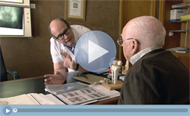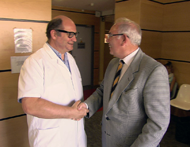Hip Replacement Surgery
What is the difference between cemented and cementless total hip replacement?
A cemented total hip replacement uses cement to secure an implant to the bone, while with cementless technology the bone heals directly to the prosthesis. The results of cemented and cementless total hip replacement are essentially identical. Theoretically, cementless hip replacements should have a longer lifetime and are desirable in patients who have good enough bone quality to accommodate a cementless implant.Who should get a cemented total hip replacement and who should get a cementless total hip replacement?
The answer can be realized by examining several ways in which an artificial hip can fail. These include implant fracture, wear and loosening. Although metal can break, the new super-alloy metals has minimized this problem. Plastic wear is another problem, but advances in design and materials has reduced this as well. Implant loosening continues to be a concern, however. The weak link for most active patients is the cement bond between the implant and bone. By adding a porous, rough surface to the implant and eliminating the use of bone cement, bone ingrowth into the implant can occur, providing a living bond between the implant and bone. It is theorized that, over time, the constant stress of daily activities would actually strengthen the bone-implant link rather than weaken it.Experience has shown that young, active or heavy patients are most likely to loosen a cemented replacement. For these patients, the cementless replacement appears to be the most durable design. Patients with poor bone quality or with less active lifestyles are candidates for cemented total hip replacement.
What are the potential problems?
The most common complications of total hip surgery can now largely be avoided. Before surgery each patient receives a complete medical examination by a doctor, as well as routine testing.Possible local complications include: loosening, wear or breakage of the prosthesis, hip dislocation, infection, pain, stiffness, leg length inequality, delayed healing of bone and soft tissues, and heterotopic bone formation. Other rare complications include fracture of the femur or acetabulum, nerve and vascular injury.
Medical complications include: thrombophlebitis, pulmonary embolism (blood clot), urological complications and even death (0.1%) Other rare complications, which can be encountered with any surgery, include cardiac, digestive and lung problems.
What is the short-term outlook after total hip replacement?
In general, most patients take six weeks to three months to recover after a hip replacement and experience pain relief and improvement in function. However, improvements can be realized for over a year after the operation. In rare cases, patients with uncemented hips have noted a mild degree of thigh discomfort that persists for six to twelve months after surgery during the period of bone ingrowth. For the most part, however, this pain disappears with time.What is the long-term outlook?
Experience with both cemented and cementless total hip replacement has shown that a certain percentage of patients will require further surgery. Revision surgery is necessary due to infection and because implants break, loosen and wear. Currently, it appears that cemented and cementless total hip replacement can give equivalent results. The failure rate after surgery is about 1% per year. The chance of a hip replacement lasting twenty years is about 80%.Is revision hip surgery different?
Yes and no. Revision surgery is different in that the original components are removed and new components are implanted. The technical aspects of the surgery are more complex than the original total hip replacement. However, the preparation for surgery and hospital experience tend to be very similar to the primary total hip replacement. The choices for implant are also the same, both cemented and cementless components are used depending on the patient’s needs and the quality of bone present at surgery.What happens if my hip gets infected?
Infection after surgery is one of the most serious complications. Like other complications, it is better avoided than treated. At the clinique Sainte Isabelle all joint replacement surgery is done in special laminar flow operating rooms designed to keep out dust, germs and unclean air. The surgeons also wear “space suits”. These full body suits, worn over normal scrubs, let the surgeons move and breathe without spreading germs, since an exhaust tube carries dirty air out of the room.Additionally, all patients are given antibiotics before and after the procedure. Thanks to these measures, the infection rate at The Clinique sainte Isabelle is less than half of 1%. If infection does occur, the patient is first given antibiotics. If the infection does not clear up, the implant will have to be removed and the patient is scheduled for revision surgery. The patient is treated with intravenous (I.V.) antibiotics. Months later, after the infection has cleared up, a new prosthesis is implanted.

Click the video above to see how Operation France helped arrange a hip replacement for Dennis Comey

Operation France are exclusive agents for Clinique Sainte Isabelle - French Orthopaedic Hospital

Patients enjoy comfortable door-to-door travel service to and from the clinic

Hugh Philips of Operation France with the world renowned orthopaedic surgeon, Dr Renaux
